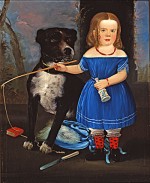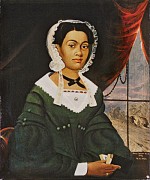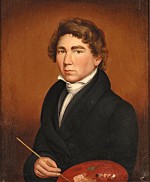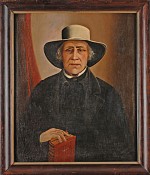Column Name
Title
Have you ever visited the American Folk Art Museum? Although it is located just across Broadway from Juilliard, this superb museum inexplicably remains almost unknown to the Juilliard community. The museum’s latest exhibition, “Artist and Visionary: William Matthew Prior Revealed,” features an enigmatic painter who lived from 1806 to 1873, and it has garnered much praise, including from New York Times critic Ken Johnson, who called it “fascinating.”
American Folk Museum, 2 Lincoln Square, Columbus Avenue at 65th Street. (212) 595-5933
Closed Monday; Tuesday-Saturday noon-7:30 p.m.; Sunday noon-6 p.m.
American Folk Museum, 2 Lincoln Square, Columbus Avenue at 65th Street. (212) 595-5933
Closed Monday; Tuesday-Saturday noon-7:30 p.m.; Sunday noon-6 p.m.
American Folk Museum, 2 Lincoln Square, Columbus Avenue at 65th Street. (212) 595-5933
Closed Monday; Tuesday-Saturday noon-7:30 p.m.; Sunday noon-6 p.m.
William Matthew Prior, Child in Blue With Dog (1848), oil on canvas, 35 5/8 x 29 in.
(Photo by John Bigelow Taylor; courtesy of Fenimore Art Museum)William Matthew Prior, Nancy Lawson (1843), oil on canvas; 30 x 25 in.
(Photo by Shelburne (Vt.) Museum)William Matthew Prior, The Artist as a Young Man: Self Portrait (1825) oil on canvas; 31 1/8 x 26 15/16 in.
(Photo by Richard Walker; courtesy of Fenimore Art Museum)Body
The scope of Prior’s work is stunning as it ranges from primitive traditional folk painting to sophisticated society portraiture. No one knows exactly how he acquired his skills. Scholars surmise that he must have had early training; most so-called folk artists were self-taught. Prior may even have studied with Gilbert Stuart, the famed portraitist of George Washington; there are two amusing paint-on-glass copies he made of Stuart’s portraits of George and Martha Washington in the exhibit.
Prior was born in Maine, and, like many other nonacademic painters, started out as a decorator and sign painter. He worked mostly in the limner tradition—limners were itinerant artists who moved from town to town painting portraits of middle class people. Prior’s oeuvre also includes a few landscapes.
Prior moved to Boston in 1840, where he married and set up a studio, employing his in-laws in his enterprise. Achieving great success as a portraitist, he traveled up and down the eastern seaboard, painting likenesses of people who commissioned his work. The artists in his studio, the Prior Group, painted portraits to suit the taste and budget of their clients, which partly explains the varying quality of the resulting works, which range from sophisticated, very finished portraits to flat ones without shadow or contour. Indeed, Prior, a pragmatic businessman, offered discounted paintings without shading at one quarter the price. One of his flat pictures still has a price tag on its back: $2.17.
The artist, a fervent abolitionist, was one of the first North American painters to depict African-American sitters with dignity, as in the portraits of Nancy and William Lawson, which he painted in May 1843. The excellent catalog accompanying the exhibit explains that it took an act of courage for Prior to portray the Lawson’s as successful people—both were dressed in finery and William held a lighted cigar. This was unusual in a time when racism was especially virulent, even in the Boston area, a mecca for abolitionism. These expensive portraits probably cost about $40, which would have been more than a week’s wages for Mr. Lawson, a clothing dealer.
The Lawsons appear to have been Millerites—followers of Reverend William Miller, a Baptist minister who predicted the end of the world in 1844. Their portraits thus tie in to one of Prior’s most unusual works, his portrait of Miller, which was made between 1845 and 1855. This portrait is especially interesting since Prior claimed to paint it from memory (the minister died in 1849)—he counted it among a group he called his “spirit effect” portraits.
My own favorite piece in the show is Child in Blue With Dog (1848). In it a girl who is about 5 or 6 years old standing beside an enormous dog. Her bright blue dress contrasts with her white bloomers and red polka-dot stockings. Though she’s small, she seems to be in complete command of the situation with a whip in one hand and a ceramic bell or toy in the other. Mysteriously, a knife, a small red book, and her blue frilly hat lie on the ground. Has there been a battle between human and beast? Both girl and dog stare out at us, the girl calmly, and the dog intently, his ferocity presumably tamed by his little mistress. The painting, a much beloved folk masterpiece, is renowned for its balance and contrast of colors, lines, and emotions. I couldn’t help but think of the recent film Life of Pi (based on the novel by Yann Martel), in which a small Indian boy who’s stranded at sea tames a tiger.
Prior’s 1825 self-portrait, perhaps used as an advertisement, reveals a confident, handsome young man who meets our gaze with paintbrush and palette in hand. Unlike most folk art portraits, this one fits the tradition of academic self-portraits. Certainly, Prior appears remarkably mature for being a mere 19 years old.
The handsome exhibition is beautifully installed in the Folk Art Museum, which opened its Lincoln Square facilities in 1989. Some may recall that from 2001 to 2011, its main branch was located on West 53rd Street, a few buildings away from the Museum of Modern Art. Unfortunately the museum had to move back to 2 Lincoln Square, where the limited space allows it to show about one-sixth of the works that were on view at 53rd Street. However, it still possesses a significant permanent collection, excellent temporary exhibitions, and sponsors various musical events and lectures. Plus it’s open most days until 7:30 and has a splendid gift shop—and admission is free.








